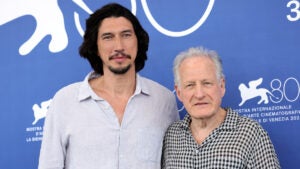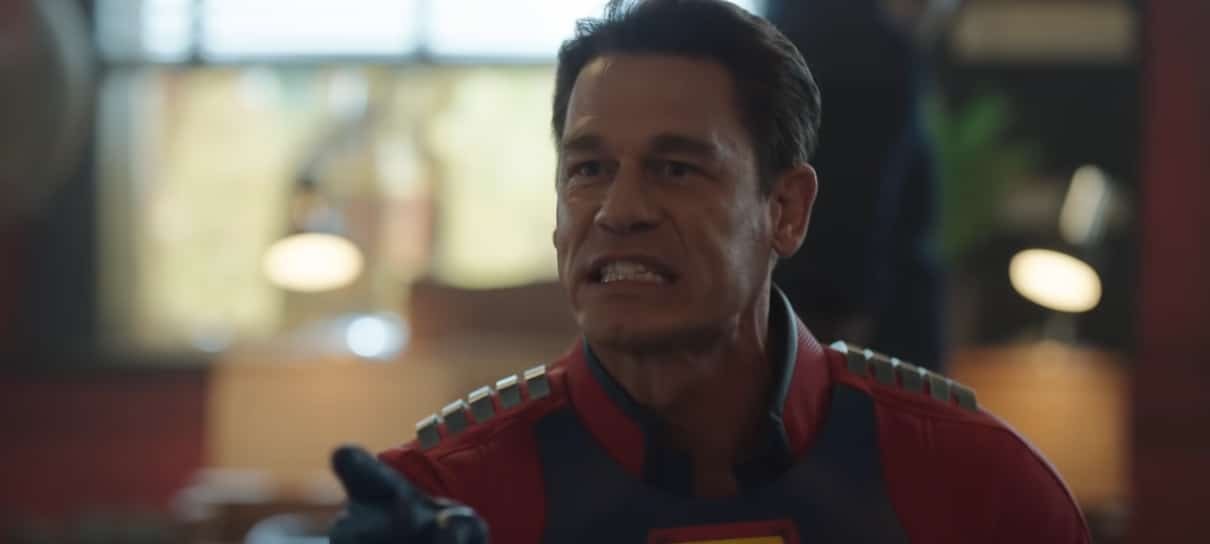In hindsight, it seems inevitable that Michael Mann would one day set his camera on a Ferrari’s sleek red contours. What an obvious match, what a perfect pair, what more fitting a subject for a filmmaker with a singular obsession for singular obsessives, for a screen stylist who’s spent five decades aestheticizing efficiency. And so, it should come with little surprise that “Ferrari” astounds when Mann’s focus narrows to pure gear-head reverie; unfortunately, in between the film’s narrative engine often sputters and stalls.
Premiering at the Venice Film Festival and heralding a welcome return to the big screen after eight long years away, Mann’s high-verve biopic also marks a formal shift towards a more classical compositional style. The film forgoing the digital experimentation that colored Mann’s past four films for something closer to tone and tempo to prestige TV – that is, at least until the motors roar.
The filmmaker clarifies his intentions right from the start, opening on black-and-white stock footage of the real Enzo Ferrari, taken from Ferrari’s 1920 peak as a racing hotshot. As prototype race cars whirl around a track, the camera pulls closer and closer to the man’s face, slowing time to better register his fixed stare. Skipping three decades ahead, we next see Enzo (a typically self-contained Adam Driver, but you knew that) walking with a limp but sharing that same dogged look. And hey, the engineer’s been busy: By the time the narrative picks up in 1957, Ferrari’s built an automotive empire, raised a family, lost a son, started a second family in secret, and nearly gone broke.
All that living takes a toll, both in countenance (see the limp, or Driver’s shock-white hair) and at home. Though Enzo has inured himself to death’s frequent visits (“I’ve built a wall,” he says, coolly recalling the many friends, colleagues and employees who never made it to the finish line), his wife Laura (a ferocious Penelope Cruz) holds her anguish close to the surface.
Here are parents in mourning, grieving a son lost just the year prior, but whose long illness sapped joy from their marriage long ago. Once more, Mann loses little time establishing the parameters of this tempestuous duo, introducing the couple as Laura confronts Enzo about his philandering by pulling a pistol on him and firing point blank. “I’d sooner re-arm Germany before giving that woman a gun,” quips Enzo’s pint-sized Mamma.
Though Cruz has an intuitive feel for such larger-than-life figures, she is forced to work against a clunky script full of expositional speechifying and primetime drama set-ups (see that quipping Nonna). The Spanish star is often at her best when given the space to wordlessly play up that Our Lady of Sorrows archetype, saying more with a pen, a stack of papers, and a furrowed brow than with whole pages of Troy Kennedy Martin’s on-the-nose dialogue. Now, we shouldn’t be too harsh, as the “Ferrari” screenwriter (and British television stalwart) presumably delivered this final work long before he passed away in 2009, but the creakiness of the source material is hard to overlook.
Nowhere is that more apparent than with the other woman in Enzo’s life. You see, longtime mistress Lina (an oddly cast Shailene Woodley, with an accent that swerves more than many of the cars onscreen) is also the mother of Ferrari’s last-living heir – if only the louse would get around to formally recognizing the boy. Granted, Enzo would just as happily keep the side-family Modena’s worst-kept secret, but at least give him credit for taking a stronger stance than the filmmakers, who never find a way to make these characters standout. Lina and son serve as a dramatic device for an early-on bait-and-switch reminiscent of the “Mad Men” pilot, subjects of conversation and pit stops for quick pathos, all while displaying shadings and motivations that somehow change from scene to scene.
To be fair, this is partly by design. As “Ferrari” tells us right from the start, we are meant to experience this chaos through the blinkered gaze of a man with only one thing on his mind. And the only thing on Enzo’s mind is winning the next race. More specifically, winning the 1957 Mille Miglia competition — a marathon 1,000-mile tour across the Italian countryside, through Rome, and into the history books – where victory promises to resolve Ferrari’s mounting financial concerns.
Paradoxically, “Ferrari” best succeeds as a psychological portrait when it takes the character out of the home, leaving behind the more overt biographical elements to focus on Enzo the observer, watching his Ferrari racers tear across the track, and Enzo the entrepreneur, recalibrating his team when needed. Of course, Enzo the racer has long-since retired, but the man retains the necessary focus and chilling sangfroid required by those making life-or-death maneuvers by the millisecond – a point hammered home when mortality strikes well before the race even begins.
In one of the film’s most interesting sequences, we follow Enzo to church, where the priest gives a homily comparing the autoworkers of Modena to the carpenters of Nazareth. In a clear nod to “The Godfather,” Mann soon begins crosscutting between the flock taking communion and the Ferrari racers running time-trials, imparting a sense of monomaniacal religious fervor that extends throughout an entire community. Enzo might be more obsessive than most, but he is nonetheless a product of his surroundings.
Marvel at the expertly assembled racing scenes and you might walk away a believer as well. If the handful of time trials and track races all boast impeccable technical chops – with particular mention for the sound-design, which layers Daniel Pemberton’s high-spirited score into the hum and thrum of wheels and motors and combustion engines all working at full blast — the climactic Mille Miglia race sends the film onto a whole other level.
Seizing upon an ever-shifting Italian landscape (instead of a visually monotonous track), Mann cracks open a delirious new toolbox to convey an overwhelming sense of speed. You never do realize just how fast these cars are going until you watch familiar landmarks and groups of cheering fans ping across the screen in the blink of an eye, flying through your field of vision like afterthoughts, replaced quickly by something new.
Mann is hardly immune to such worship, but he also recognizes that speed can be a mercurial god. The climactic sequence is thrilling, inspiring even, until, in just another blink of an eye, it suddenly is not. And if Enzo has closed himself to human compassion, the filmmaker bets that the viewers have not – lending the film’s closing act an awesome, awful majesty as engineering grace gives way to human tragedy. “Ferrari” dawdles, then dazzles, and finally disturbs.
Note: This article have been indexed to our site. We do not claim legitimacy, ownership or copyright of any of the content above. To see the article at original source Click Here














